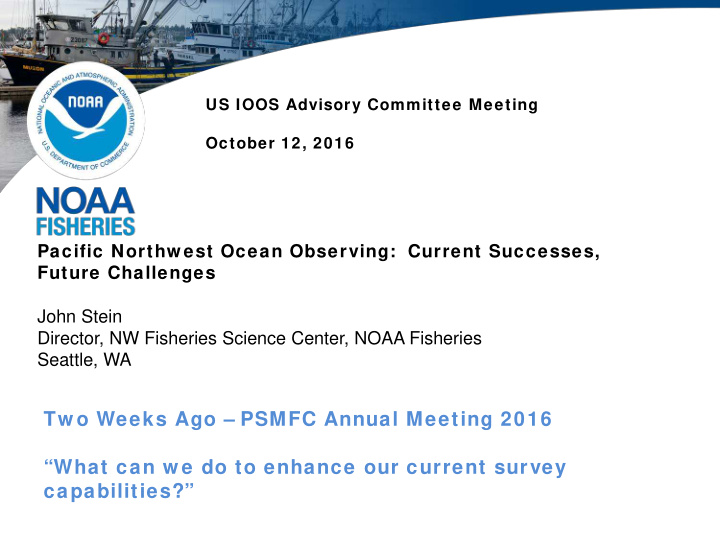



US IOOS Advisory Committee Meeting October 12, 2016 Pacific Northw est Ocean Observing: Current Successes, Future Challenges John Stein Director, NW Fisheries Science Center, NOAA Fisheries Seattle, WA Tw o Weeks Ago – PSMFC Annual Meeting 2016 “What can w e do to enhance our current survey capabilities?”
Challenges (Opportunities) – High Level • Dealing with the “unexpected” (e.g., marine heat wave) • Linking observations with process studies (e.g., Puget Sound coho in 2016 – we missed) • Research to Operations (e.g., Salish Sea Marine Survival Project, Newport Line) • Harnessing the power of ‘omics’ (e.g., eDNA) U.S. Department of Commerce | National Oceanic and Atmospheric Administration | NOAA Fisheries | Page 2
Successes – High Level (not all) • PNW HABs • Ocean Acidification • Telemetry • Acoustics • Partnership U.S. Department of Commerce | National Oceanic and Atmospheric Administration | NOAA Fisheries | Page 3
Near-real time offshore monitoring data early warning ESP (18 m) of toxic HABs! “Lab in a Can” 4
Ocean Acidification • Effective, sustained collaboration • 3 legged stool of Obs/Lab/Modeling • Why effective the three Cs – Communication, Coordination, Collaboration • Leads to leveraging existing resources • Synergism from the close interactions among science teams U.S. Department of Commerce | National Oceanic and Atmospheric Administration | NOAA Fisheries | Page 5
Acoustic Telemetry – Fish Tags Moore et al. (Mar. Ecol. Prog. Ser. 2015)
Acoustics – Seafloor Mounted 7
38-kHz Acoustics on gliders 120-kHz Biological scattering layers (krill?) and discrete high intensity regions, thought to be fish schools. 2013 SaKe Survey Lines Greene, C.H., E.L. Meyer-Gutbrod, L.P. McGarry, L.C. Hufnagle Jr., D. Chu, S. McClatchie, A. Packer, J.-B. Jung, T. Acker, H. Dorn, and C. Pelkie. 2014. A wave glider approach to fisheries acoustics: Transforming how we monitor the nation’s commercial fisheries in the 21st century. Oceanography 27(4):168–174, http://dx.doi.org/10.5670/oceanog.2014.82.
Models: forward projections can provide adaptive sampling (predicted “optimal habitat” using SST, Chl and SSH) Northward shift/extension of habitat, surveys and sampling in 2015 2011 2015
‘Omics – Biotech for Environmental Intelligence • Understanding how organisms adapt under rapidly changing conditions . Genetic code has the information ‘Omics technologies are the tools Metabolomics Proteomics Phenomics Metagenomics & Epigenetics Metatranscriptomics Genetics & Genomics
Why is ‘Omics Rapidly Emerging Bioinformatics and enhancement of IT capabilities underpins the success of ‘omics
‘Omics to Support Ecosystem Understanding Analytical ‘omics – plankton community Current – chlorophyll
ORHAB – Partnership at Core And Challenges • 10 years to get to a point could develop a operational HAB early warning system • A source of funds for operations BUT not perfect • Demonstrating power of ESP when coupled with NANOOS assets • No clear path to operationalize ESP U.S. Department of Commerce | National Oceanic and Atmospheric Administration | NOAA Fisheries | Page 13
WRAPPING UP 14
‘Wicked’ Challenges • Perpetual challenge in moving from proof of concept to sustained operations • Surmounting the barriers to sustained collaboration across agencies/entities • ‘Boring is bad’ (real impact of flat budgets) • Promise of Ecosystem Based Management – challenge is there is no single entity U.S. Department of Commerce | National Oceanic and Atmospheric Administration | NOAA Fisheries | Page 15
MY PERSEPECTIVE • Technology is not the issue • The research is not the issue, most of the time • The age old issue – putting the technology in place for sustained use/benefit • Current fiscal conditions making harder? • Is the shift permanent? U.S. Department of Commerce | National Oceanic and Atmospheric Administration | NOAA Fisheries | Page 16
Recommend
More recommend